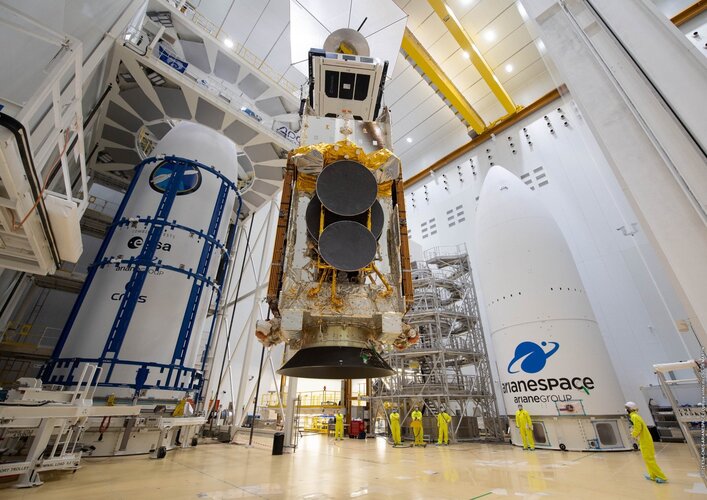
Copernical Team
Technologies and concepts for the satellite navigation systems of the future
 Using the best navigation technologies to bring the greatest benefit to their users - this is the what the Galileo Competence Center at the German Aerospace Center is working towards. Together with DLR's institutes, facilities and partners, products are being developed to ensure the continuous improvement of the European Galileo satellite navigation system. The Galileo Competence Center is now o
Using the best navigation technologies to bring the greatest benefit to their users - this is the what the Galileo Competence Center at the German Aerospace Center is working towards. Together with DLR's institutes, facilities and partners, products are being developed to ensure the continuous improvement of the European Galileo satellite navigation system. The Galileo Competence Center is now o Keeping our eyes on New Horizons
 New Horizons remains healthy and continues to send valuable data from the Kuiper Belt, even as it speeds farther and farther from Earth and the Sun. Our team has been extremely busy since I last wrote in the spring. One of the most important activities since then has been ground testing, uploading and flight-testing new software for our Alice ultraviolet spectrometer and our main (Command and Da
New Horizons remains healthy and continues to send valuable data from the Kuiper Belt, even as it speeds farther and farther from Earth and the Sun. Our team has been extremely busy since I last wrote in the spring. One of the most important activities since then has been ground testing, uploading and flight-testing new software for our Alice ultraviolet spectrometer and our main (Command and Da Mars helicopter Ingenuity approaches 14th flight
 The Mars helicopter Ingenuity is ready for a short Martian flight as early as Saturday to test summer weather conditions that have arrived at its location on the Red Planet after two weeks of no communication because of blockage by the sun.
The flight, Ingenuity's 14th, is brief and simple by design. As weather at Jezero Crater gets warmer, the aircraft's rotors must turn faster to achi
The Mars helicopter Ingenuity is ready for a short Martian flight as early as Saturday to test summer weather conditions that have arrived at its location on the Red Planet after two weeks of no communication because of blockage by the sun.
The flight, Ingenuity's 14th, is brief and simple by design. As weather at Jezero Crater gets warmer, the aircraft's rotors must turn faster to achi France launches state-of-art military communications satellite

Paris created a space force command in July 2019, amongst concerns that rival countries were heavily investing in space technology, seen as a new military frontier.
The satellite "is designed to resist military aggression from the ground and in space, as well as interference," French air and space force spokesman Colonel Stephane Spet told AFP.
The Ariane 5 rocket carrying the Syracuse 4A satellite took off from Kourou, in French Guiana late Saturday, with the mission accomplished 38 minutes and 41 seconds after takeoff.
The satellite can survey its close surroundings and move itself to escape an attack.
"Thanks to its state-of-the-art equipment (anti-jamming antenna and digital transparent processor on board), Syracuse 4A will guarantee a high resistance to extreme jamming methods," launch provider Arianespace wrote in its mission description.
Marc Finaud, an expert in weapons proliferation at the Geneva Centre for Security Policy, told AFP the satellite was also protected against the electro-magnetic pulses which would result from a nuclear explosion.
Europe’s data-driven satellite launched

One of the largest telecommunications satellites ever built in Europe has been launched and is on its way to geostationary orbit.
Ariane 5 sets new record on latest launch

Europe’s Ariane 5 has delivered two telecom satellites, SES-17 and Syracuse-4A, into their planned orbits.
Data-driven satellite ready to launch

One of the largest telecommunications satellites ever built in Europe – which will supply high-speed data links for commercial aviation as well as providing connectivity to underserved areas to accelerate digital inclusion – is poised for launch.
Europe’s largest telecom satellite ready to launch

The largest telecommunications satellite ever built in Europe – which will provide high-speed data links for commercial aviation as well as providing connectivity to underserved areas to accelerate digital inclusion – is poised for launch.
NASA targeting Feb. 2022 to launch new lunar program Artemis

NASA said Friday it is now targeting February 2022 for the uncrewed lunar mission Artemis 1, the first step in America's plan to return humans to the Moon later this decade.
The space agency had initially wanted to launch the test flight by the end of this year, with astronauts on the ground by 2024 on Artemis 3, but the timeline has slipped back.
It achieved a major milestone Wednesday when it stacked the Orion crew capsule atop its Space Launch System megarocket, which now stands 322 feet (98 meters) tall inside the Vehicle Assembly Building at NASA Kennedy Space Center in Florida.
After further tests, it will be wheeled out to the launch pad for a final test known as the "wet dress rehearsal" in January, with the first window for launch opening in February, officials told reporters on a call.
NASA completes mega-moon rocket stacking

NASA has completed stacking of the agency's mega-Moon rocket and spacecraft that will launch the next generation of deep space operations, including Artemis missions on and around the Moon. Engineers and technicians successfully secured the Orion spacecraft atop the fully assembled Space Launch System (SLS) rocket at the agency's Kennedy Space Center in Florida just before midnight Oct.

